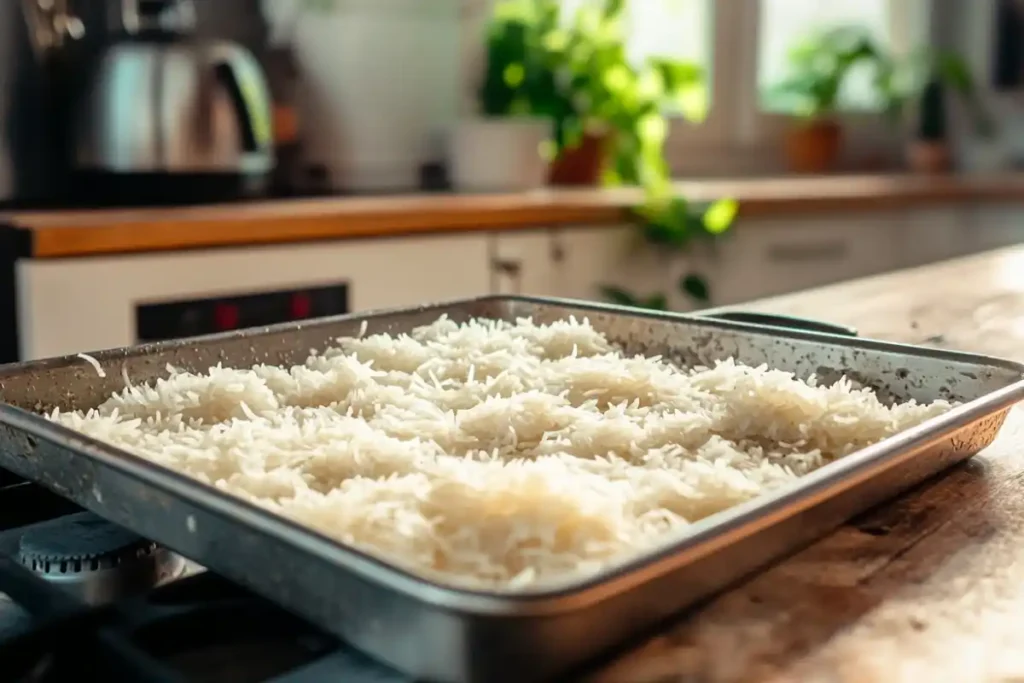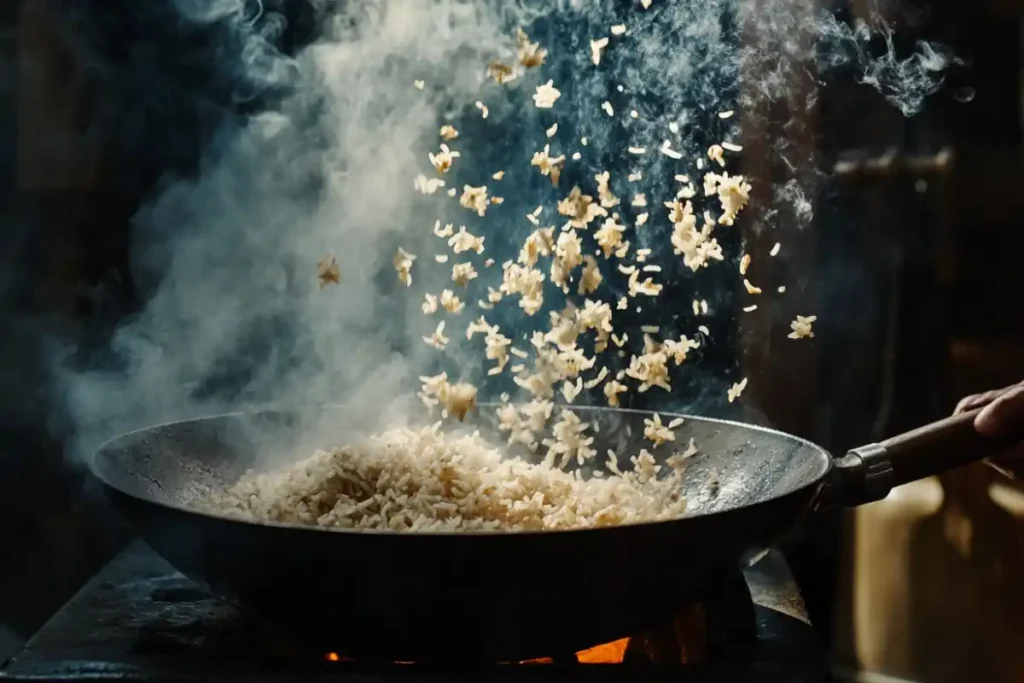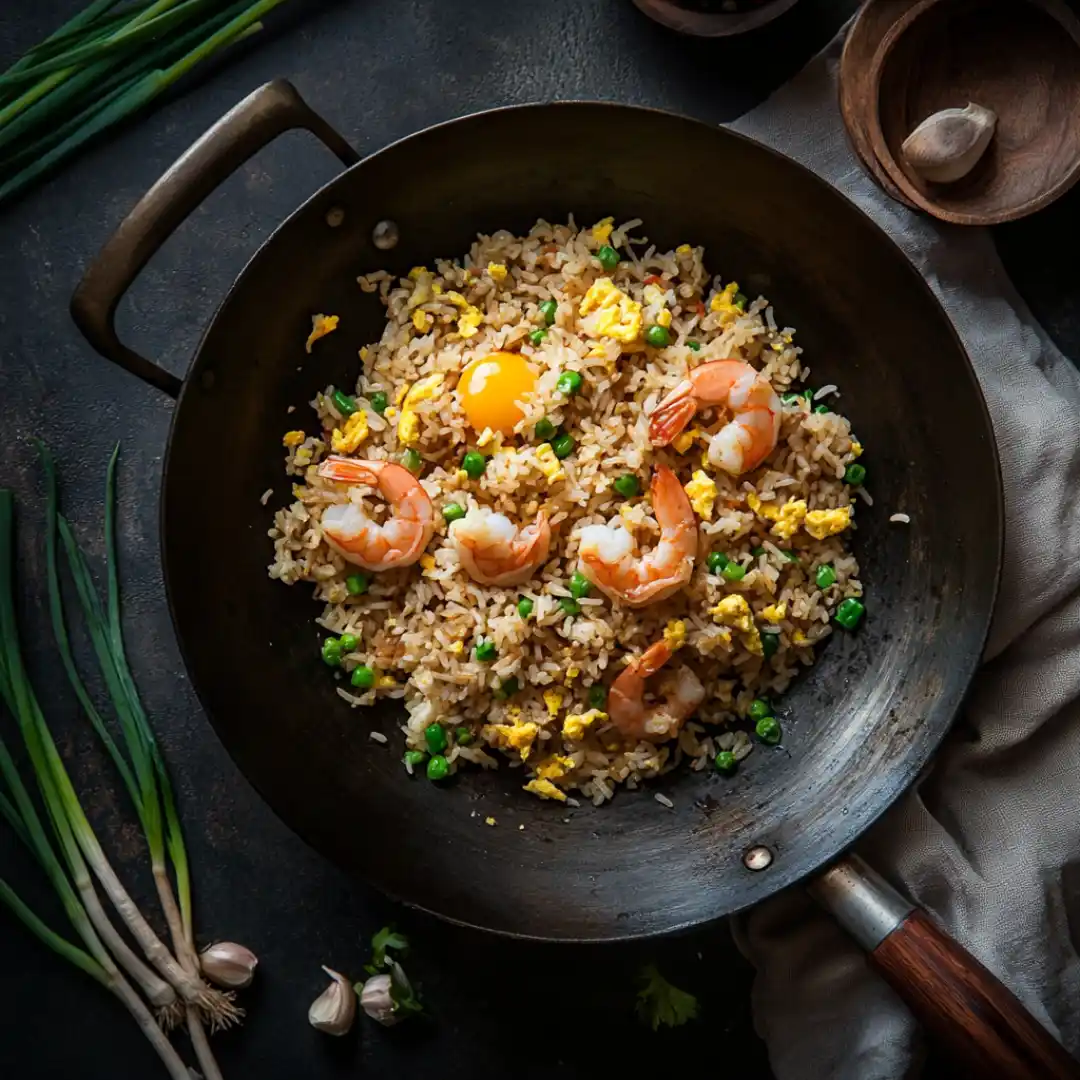There’s something magical about the aroma and taste of authentic Chinese fried rice. Whether you’ve had it at a bustling street stall in Guangzhou or your favorite local restaurant, it’s hard to replicate that perfect balance of flavor, texture, and smokiness at home. Many have asked, “What is the secret to Chinese fried rice?” and the truth is, there isn’t just one. It’s a symphony of small secrets working together.
In this article, we’ll uncover the real techniques used in Chinese kitchens that elevate a simple bowl of rice into something unforgettable. We’ll explore the science behind day-old rice, the mystery of wok hei, the secret seasonings that don’t overpower, and the finishing touches that make it all pop. You’ll also discover common mistakes to avoid and delicious regional variations you can try next.
Let’s dive in!
Understanding the Basics of Chinese Fried Rice
What Makes Chinese Fried Rice Unique Compared to Other Variants?
You might think fried rice is just rice, egg, and soy sauce tossed together, right? Not quite. Chinese fried rice stands apart because of its distinct balance of flavor, texture, and aroma. Unlike Thai or Indonesian versions that lean sweeter or spicier, Chinese style fried rice is more savory and umami rich.
The main difference lies in technique and restraint. Instead of drowning the dish in sauce, Chinese chefs let the ingredients shine. You’ll often find a more delicate use of soy sauce, a touch of white pepper, and sometimes just a sprinkle of salt. The goal? To make every grain of rice taste rich, separate, and lightly crisped without feeling greasy.
This careful layering of flavor is also supported by the type of rice. Medium or long grain rice, like jasmine or even leftover basmati, is preferred because it cooks up fluffy and stays separate after frying. Short grains tend to clump, which is a no go.
So what is the secret to Chinese fried rice? It’s a blend of culinary know how, ingredient control, and an understanding of how heat interacts with food. Pretty fascinating, huh?
Cultural Origins and Regional Styles of Fried Rice in China
Fried rice has deep roots in Chinese history. It likely originated during the Sui Dynasty, when leftover rice needed repurposing. Since then, it’s evolved into countless styles, from the Cantonese Yangzhou fried rice to the rich, saucy Fujian fried rice.
Each region puts its spin on it. Cantonese versions are light and packed with shrimp and char siu, while northern styles may use stronger sauces. In places like Shanghai or Hong Kong, you’ll even find seafood infused oils or duck fat used for frying, talk about elevated flavor!
Understanding these regional nuances gives you a clearer picture of what fried rice should be: flexible, flavorful, and rooted in tradition.
The Role of Day Old Rice and How to Prepare It
Why Is Day Old Rice Ideal for Fried Rice?

Ever noticed how homemade fried rice turns out mushy while restaurant versions stay fluffy and crisp? The secret’s in the rice, day old rice, to be exact. When rice sits overnight in the fridge, its surface dries out just enough to prevent it from clumping in the wok. This texture allows each grain to fry rather than steam, which is essential for that crave worthy bite.
So, what is the secret to Chinese fried rice? Dry, cold rice is at the heart of it. It doesn’t soak up too much sauce or oil and holds up beautifully under high heat.
Now, if you’re in a pinch and forgot to prep a batch the day before, no worries. Just spread freshly cooked rice on a baking sheet and blast it with a fan or cool it in the freezer for 30–45 minutes. It’s not perfect, but it’ll get the job done in a flash.
For a beginner friendly recipe to try it out, check out this tasty Chicken Fried Rice Recipe.
Alternative Methods: Drying Fresh Rice with a Fan or Baking
Let’s say you’re short on time. Here’s a workaround: Cook your rice as usual, then lay it flat on a tray. Fan it, refrigerate it, or even bake it at a low temp (200°F) for 10–15 minutes. The goal is simple, draw out moisture.
Bonus tip? Cook your rice with slightly less water than usual. This trick gives it a head start in drying, making it ideal for same day frying.
Wok Hei: The True Signature of Restaurant Style Fried Rice
What Is Wok Hei and Why It Matters
Ask any Chinese chef and they’ll tell you: the soul of great fried rice is wok hei. Translated as “breath of the wok,” wok hei is the complex aroma and flavor you get when food meets super-high heat in a seasoned wok. It’s smokey, a little charred, and unmistakably delicious.
So, what is the secret to Chinese fried rice that gives it that irresistible edge? You guessed it, wok hei.
Achieving it at home isn’t impossible, but it does take a bit of effort. The trick is to heat your wok until it’s screaming hot, like, nearly smoking. Then, quickly toss your ingredients in. Use high smoke point oil like peanut or grapeseed, and don’t crowd the pan. Let the ingredients sear and develop flavor.
You’ll smell it when it happens, it’s that toasty, nutty aroma that tells you you’re doing it right.
How to Achieve Wok Hei at Home with Standard Equipment
Don’t have a restaurant grade wok burner? That’s okay! Use a carbon steel wok or heavy, duty skillet. Preheat it dry for a few minutes, add oil, and move fast.
A few tricks to boost your wok hei game:
- Use smaller batches.
- Keep your ingredients dry.
- Don’t stir constantly, let things sit and sear.
Even on a home stove, these steps can help you capture that elusive “restaurant taste.”
Oh, and if you’re still wondering what is the secret to Chinese fried rice, it’s this: heat, technique, and timing all dancing together.

Choosing the Right Ingredients for Authentic Flavor
Core Ingredients: Eggs, Rice, Soy Sauce, and Aromatics
Let’s be honest, great fried rice starts with great basics. You don’t need anything fancy, but you do need the right combo. At the heart of it all is rice (obviously), eggs, a splash of soy sauce, and your favorite aromatics like garlic, ginger, and green onions.
Eggs should be lightly beaten and added early so they coat the rice instead of forming big chunks. This helps bind flavors and add that golden, savory layer.
When it comes to soy sauce, less is more. Use light soy sauce for seasoning and color, not dark soy (which is richer and better in moderation). And don’t forget salt, yes, salt! It might sound odd with soy sauce in the mix, but salt helps balance the umami without overloading on sauce.
Add garlic and scallions at the right time, near the end, for that fresh pop of flavor that screams authentic Chinese fried rice.
Luxury Additions: Duck, Lobster, and Infused Oils
Now here’s where you can get creative. If you’re craving restaurant style flair, toss in barbecue pork, shrimp, or even lobster. Fancy? Yes. Worth it? Absolutely.
Infused oils, like shrimp oil or rendered chicken fat, can elevate your dish to another level. These oils carry rich, meaty notes that coat every grain of rice with flavor. One whiff, and you’ll swear you’re dining in a five star Hong Kong bistro.
Cooking Techniques and Timing for Perfection
Frying Ingredients Separately: Why It Improves Flavor and Texture
Here’s something that might surprise you, don’t throw everything into the pan at once. Really. One of the best kept secrets to Chinese fried rice is cooking your ingredients separately and then combining them at the end. Why? It keeps textures sharp, flavors clean, and moisture in check.
Start with your proteins, shrimp, chicken, or tofu. Give them a quick sear and set them aside. Next, toss in your veggies. Root vegetables like carrots go first because they take longer to soften. Quick cooking veggies like peas or scallions can come later.
Finally, in goes the rice, followed by eggs (if not already cooked), and then you stir everything together in the final toss. This method prevents sogginess and ensures every component shines. And hey, it gives you total control over doneness and flavor.
Controlling Moisture: Steam vs. Rice Cooker for Optimal Results
Believe it or not, your rice cooking method plays a huge role in the final texture. Steam cooking rice gives you more control over moisture absorption, ideal when prepping for fried rice. You want every grain to hold its shape without being sticky.
While rice cookers are convenient, they often produce slightly wetter rice. That’s not a dealbreaker, but if you’re chasing that authentic takeout texture, consider steaming your rice or using the stovetop method with less water.
So, what is the secret to Chinese fried rice? It’s all in the details. A little patience during prep goes a long way toward that perfect, fluffy result.
Flavor Enhancement Secrets Beyond Soy Sauce
Salt and MSG: Umami Boosters That Don’t Muddle Flavor
When people wonder, what is the secret to Chinese fried rice?, they often think it’s just soy sauce. But here’s the twist, soy sauce alone won’t give you that deep, savory punch. Instead, chefs often rely on a mix of salt and MSG to enhance the natural taste of the ingredients without overpowering them.
Using just soy sauce can make your fried rice too wet or dark. Salt lets you control the flavor better. Add a pinch during cooking and taste as you go. As for MSG? It’s not the villain some think it is. A small dash adds that unmistakable umami kick found in restaurant dishes.
This subtle combo keeps the flavor balanced while letting your aromatics and proteins shine. And guess what? It’s often what separates a dull homemade batch from an unforgettable plate of fried rice.
Oyster Sauce, Fish Sauce, and Kecap Manis: When and How to Use
Let’s spice things up. If you want to layer in deeper, richer flavors, reach for oyster sauce. It’s sweet, salty, and packed with umami. A small spoon goes a long way.
Fish sauce adds boldness but should be used sparingly, it’s pungent! And kecap manis, the sweet Indonesian soy sauce, brings a caramel-like note that works wonders in meat-based fried rice.
Just remember, balance is everything. Don’t flood your rice, drizzle lightly and mix well. When done right, these sauces help answer that tasty mystery: What is the secret to Chinese fried rice?
Advanced Pro Tips From Chinese Chefs
Infused Oils: Shrimp Shell and Chicken Skin Oil for Depth
You want flavor bombs? Here’s where it gets next level. Top chefs often use infused oils to add insane depth. Think shrimp shell oil or chicken skin oil. Sounds fancy, but it’s super doable at home.
For shrimp oil, fry the shells in a neutral oil, like peanut or vegetable, until golden and fragrant. Strain the oil, and boom! You’ve got a briny, umami-packed oil that takes your fried rice from basic to breathtaking.
Chicken skin? Bake it until the fat renders out. Then blend the crispy skin with a bit of that fat to make a rich, savory base. You can even store it like a homemade XO sauce. A spoonful mixed into your rice gives it a gourmet twist.
These infused oils coat every grain with complex flavor, making every bite burst with character.
Reducing Sauces for Concentrated Flavor Without Extra Moisture
Sauces are great, but too much liquid ruins the texture. So what do chefs do? They reduce sauces.
That’s right. Reduce soy sauce, fish sauce, or even wine in a hot pan until it thickens slightly. This cuts down moisture while concentrating the taste.
What is the secret to Chinese fried rice that doesn’t go soggy? Reduced sauces are a pro move. They bring intensity without drowning your rice. Combine that with infused oils and dry rice, and you’ve got a plate worthy of the wok gods.
Common Mistakes to Avoid When Making Fried Rice
Overcrowding the Wok and Over Saucing the Rice
If you’ve ever ended up with soggy or mushy fried rice, chances are you made one of these two classic mistakes. First up, overcrowding the wok. When there’s too much in the pan, it traps steam instead of letting ingredients fry. This robs your rice of that crisp texture and smoky aroma.
The fix? Cook in batches. It may take more time, but the payoff is huge.
Second, be careful not to drown your rice in soy sauce. While tempting, it adds moisture and muddies the flavor. As we’ve mentioned before, what is the secret to Chinese fried rice? Controlled seasoning and heat, not sauce overload.
Not Controlling Moisture or Skipping Separate Frying Steps
Another big one, moisture control. Fresh rice with high water content leads to sticky clumps. Always dry your rice first, even if it’s freshly made.
Also, don’t skip frying components separately. When veggies, eggs, and proteins are cooked on their own, each keeps its flavor and texture intact. Combine too early, and you risk a bland, steamy mess.
Variations of Chinese Fried Rice to Explore
Yangzhou Fried Rice, Cantonese Fried Rice, and Fujian Style
Chinese fried rice isn’t just one dish, it’s a whole world of flavors. Yangzhou fried rice, a popular version from Jiangsu, features shrimp, BBQ pork, peas, and egg. It’s light, fragrant, and often seen as the gold standard.
Cantonese style fried rice leans subtle with its seasonings. It relies more on freshness and less on sauces. Then there’s Fujian fried rice, which is served with a rich, savory gravy, totally different and incredibly tasty.
Each style teaches us something new about what is the secret to Chinese fried rice. It’s not about copying one version. It’s about understanding balance, texture, and tradition.
Vegetarian and Seafood Based Fried Rice Options
No meat? No problem. Try a vegetarian fried rice with mushrooms, tofu, and seasonal veggies. Or go coastal with a seafood mix, shrimp, scallops, and even squid add natural umami without heavy sauces.
These variations are endlessly customizable and great for experimenting while sticking to traditional techniques. Keep it dry, flavorful, and fast, and you’re doing it right.
FAQs: People Also Ask
What gives Chinese fried rice its flavor?
The rich flavor of Chinese fried rice comes from a blend of aromatics (like garlic and green onions), light soy sauce, a dash of salt or MSG, and high-heat cooking that brings out the wok’s natural seasoning. When all these elements come together, they create that iconic depth of taste.
Can I make Chinese fried rice without day old rice?
Yes, you can! If you’re in a rush, cool freshly cooked rice in the fridge or spread it out under a fan for 30–45 minutes. The key is to reduce moisture so the rice stays fluffy when fried.
What type of soy sauce is best for fried rice?
Light soy sauce is preferred, it’s salty and brings color without overpowering the dish. Use it sparingly, and supplement with salt for better flavor control.
Why is restaurant fried rice better than homemade?
Restaurant rice benefits from wok hei, high BTU burners, and carefully layered flavors. But don’t worry, with the right techniques and prep, you can match that magic at home.
Conclusion
So, what is the secret to Chinese fried rice? As you’ve seen, it’s not just one thing, it’s a mix of thoughtful steps. From using dry, day-old rice to achieving wok hei and layering flavor with precise seasoning, each piece matters. Skipping one step can flatten your flavor. But when you get it all right? Pure perfection.
By cooking ingredients separately, reducing moisture, and balancing sauces, you’ll transform your fried rice from average to unforgettable. Whether you’re sticking to a simple egg version or going big with shrimp oil and infused sauces, the heart of this dish lies in technique.
Practice, tweak, and don’t be afraid to make it your own. Before long, you won’t be asking what is the secret to Chinese fried rice, you’ll be the one sharing it.
